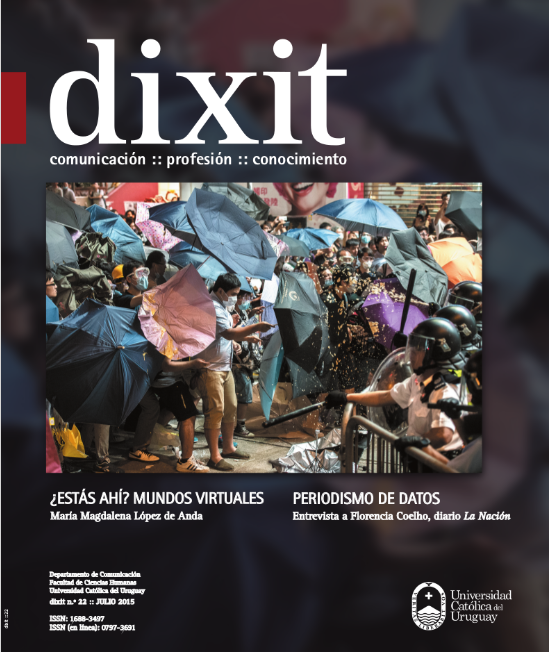¿Estás ahí? Representación y co-presencia en mundos virtuales
DOI:
https://doi.org/10.22235/d.v0i22.378Palavras-chave:
comunicación mediada por computadora (CMC), representación, co-presencia, Second Life, mundos virtualesResumo
La interacción social en mundos virtuales se experimenta por medio de prácticas que requieren formas de representación digital de quienes participan en ellas. A partir de una observación sistemática en el entorno virtual Second Life (SL), se pretende contribuir a la comprensión de algunas relaciones entre los recursos a través de los cuales los usuarios se muestran a los demás y favorecen una percepción de co-presencia. Se identifican y caracterizan siete formas de relación entre co-presencia y representación. Estas siete categorías dan cuenta de condiciones técnicas del entorno y de estrategias de los participantes para responder a determinadas dinámicas de interacción, haciendo uso de recursos de manejo temporal (ritmos de participación) y espacial (co-presencia diversificada). En conclusión, las formas de encuentro a la distancia amplían la sensación de ubicuidad de los sujetos y representan competencias clave de nuevas formas de socialidad reticular y multiescénica.
Downloads
Referências
Andersen, P. B., y Nowak, P. (2002). Tangible Objects: Connecting Informational and Physical Space (pp. 190-214). L. Qvortrup (Ed.), Virtual Space: Spatiality in Virtual Inhabited 3D Worlds. Londres: Springer.
Benedikt, M. (2008). Cityspace, Cyberspace, and the Spatiology of Information. Journal of Virtual Worlds Research, 1(1), 1-22.
Benedikt, M. (Ed.) (1991). Cyberspace. Cambridge (EUA): MIT Press.
Bodumn, L., y Kjems, E. (2002). Mapping Virtual Worlds. L. Qvortrup (Ed.), Virtual Space: Spatiality in Virtual Inhabited 3D Worlds (pp. 75-92). Londres: Springer.
Boellstorff, T. (2008). Coming of Age in Second Life: An Anthropologist Explores the Virtually Human. Princeton: Princeton University Press.
Castells, M., Ardévol, M., Linchuan, J., y Araba, S. (2007). Future assemblies: theorizing mobilities and users. New Media and Society, 9(6), 1029-1036.
Castronova, E. (2003). Theory of the avatar. CESIFO Working Papers. Recuperado de: http://www.cesifogroup.de/pls/guestci/download/CESifo%20Working%20Papers%202003/CESifo%20Working%20Papers%20February%202003%20/cesifo_wp863.pdf
Castronova, E. (2005). Synthetic Worlds: The Business and Culture of Online Games. Chicago: University of Chicago Press.
Cortazar, F. J. (1998). Ciberrelaciones: amistad, amor y sexo en los salones de chat. Comunicación y Sociedad, 34, 129-155.
Crary, J. (1990). Techniques of the Observer: On Vision and Modernity in the Nineteenth Century. Cambrigde (EUA): MIT Press.
Czarnecki, K. (2008). Building Community as a Library in a 3D Environment. Australasian Public Libraries and Information Services (APLIS), 21(1), 25-27. Recuperado de: http://web.ebscohost.com/ehost/pdf?vid=8&hid=12&sid=b793179d-6ec2-4a27-a28c-9726195f6c9e40sessionmgr2
Eco, U. (1978). La estructura ausente: introducción a la semiótica. Barcelona: Lumen.
Fornäs, J., Kajsa, K., Martina, L., y Jenny, S. (2002). In Digital Borderlands: Cultural Studies of Identityand Interactivity on the Internet. Nueva York: Peter Lang.
Fortunati, L. (2005). Is Body-to-body Communication still the Prototype? The Information Society, 21, 53-61. Doi: 10.1080/01972240590895919
Gálvez, A. (2004). Análisis de la producción de sociabilidad en entornos virtuales. Athenea Digital, 05(02). Recuperado de: http://site.ebrary.com/lib/uisantafesp/Top?channelName=uisantafesp&cpage=1&docID=10122146&f00=text&frm=smp.x&hitsPerPage=20&layout=document&p00=comunidad+virtual&sch=%A0%A0%A0%A0%A0Buscar%A0%A0%A0%A0%A0&sortBy=score&sortOrder=desc&ppg=7
Giddens, A. (1984). The Constitution of Society. Berkeley: University of California Press.
Goffman, E. (1963). Behavior in Public Places. Nueva York: The Free Press.
Headrick, R. (2000). When information came of age: Technologies of knowledge in the Age of Reason and Revolution (1700-1850). Nueva York: Oxford University Press.
Jakobson, R. (1960). Closing Statement: Linguistics and Poetics (pp. 350-377). T. Sebeok (Ed.), Style in Language. Cambridge (EUA): MIT Press.
Kampmann, B. (2002). The Ontology of Virtual Space: In search of Matrixes and Cube-machines (pp. 285-306). L. Qvortrup (Ed.), Virtual Space: Spatiality in Virtual Inhabited 3D Worlds. Londres: Springer.
Klastrup, L. (2002). Interaction Forms, Agents and Tellable Events in EverQuest Paper presented at the Proceedings of Computer Games and Digital Cultures Conference]. Tampere.
Lankoski, P., y Björk, S. (2007). Gameplay Design Patterns for Believable Non-layer Characters. [Paper presented at the DIGRA Conference].
Lengel, L. (2009). Computer-Mediated Communication 21st Century Communication: A Reference Handbook. Recuperado de: http://www.sage-ereference.com/communication/Article_n60.html
López, M. (2007). Estética y representación espacial en Ragnarok On Line. México: Universidad La Salle.
Murray, J. (1997). Hamlet en la holocubierta. El futuro de la narrativa en el ciberespacio. Barcelona: Paidós.
Nielsen, R. (2002). Collaborative Spaces: inhabited Virtual Worlds (pp. 171-210). L. Qvortrup (Ed.), Virtual Space: Spatiality in Virtual Inhabited 3D Worlds. Londres: Springer.
Nowak, K, y Rauh, C. (2002). The Influence of the Avatar on Online Perceptions of Anthropomorphism, Androgyny, Credibility, Homophily, and Attraction. Journal of Computer-Mediated Communication, 11, 153-178.
Pearce, C. (2009a). Collaboration, Creativity and Learning in a Play Community: A Study of the University of There [Paper presented at the DIGRA Conference, Uxbridge University]. Londres.
Pearce, C. (2009b). Communities of play. Emergent cultures in multiplayer games and virtual worlds. Cambridge (EUA): MIT Press.
Peirce, Ch. (1931-1966). Collected Papers of Charles Sanders Peirce (C. Hartshorne, P. Weiss y W. Burks Eds.). Cambridge (EUA): Harvard University Press.
Peirce, Ch. (1986). La ciencia de la semiótica (A. Sercovich Ed.). Buenos Aires: Nueva Visión.
Qvortrup, L. (2002). Cyberspace as Representation of Space Experience: In defence of a Phenomenological Approach (pp. 5-24). L. Qvortrup (Ed.), Virtual Space: Spatiality in Virtual Inhabited 3D Worlds. Londres: Springer.
Ravetz, J. (1998). The Internet, virtual and real reality (pp. 113- 122). B. Loader (Ed.), Ciberspace Divide: Equality, Agency and Policy in the Information Society. Londres: Routledge.
Scolari, C. (2008). Hipermediaciones, elementos para una Teoría de la Comunicación Digital Interactiva. Barcelona: Gedisa.
Sterling, B. (1994). The Virtual City [Paper presented at the Rice Design Alliance]. Houston, Texas.
Taekke, J. (2002). Cyberspace as a Space Parallel to Geographical Space (pp. 25-43). L. Qvortrup (Ed.), Virtual Space: Spatiality in Virtual Inhabited 3D Worlds. Londres: Springer.
Taylor, T. L. (2002). Living Digitally: Embodiment in Virtual Worlds (pp.40-62). R. Schroeder (Ed.), The Social Life of Avatars: Presence and Interaction in Shares Virtual Enviroments. Londres: Springer.
Thalmann, D. (s/f). Challenges for the Research in Virtual Humans. Recuperado de: http://citeseerx.ist.psu.edu/ vie-doc/download?doi=10.1.1.24.1493&rep=rep1&type=pdf
Todorov, T. (2007). La Conquista de América. El problema del otro. México: Siglo XXI.
Trabajadores de IBM inician mañana la primera huelga en “Second Life” por recorte salarial (2007). El País. Madrid. Recuperado de: http://tecnologia.elpais.com/tecnologia/2007/09/16/actualidad/1189931278_850215.html
Turkle, S. (1995). Life on the Screen: Identity in the Age of the Internet, Nueva York: Simon and Schuster.
Walther, J. (2006). Nonverbal Dynamics in Computer-Mediated Communication, or :(and the Net:('s With You, :) and you :) Alone. The SAGE Handbook of Nonverbal Communication. Recuperado de: http://www.sage-ereference.com/hdbk_nonverbalcomm/Article_n24.html DOI: 10.4135/978-1-41297-615-2.n24
Wertheim, M. (1999). The pearly gates of cyberspace. From Dante to Internet. Nueva York: W. E. Norton.
Zahavi, A. (1993). The fallacy of conventional signalling. Philosophical Transactions of the Royal Society of London, 340, 287-292.
Zhao, S. (2003). Toward a Theory of Copresence. Presence, 12(5), 445-455.
Downloads
Publicado
Como Citar
Edição
Secção
Licença
A partir da edição 32, todo o conteúdo está licenciado sob a Licença Internacional Creative Commons Attribution 4.0 (CC BY 4.0).
As edições número 29-31 estão sob a Licença Creative Commons Atribuição-NãoComercial 4.0 Internacional.
Os conteúdos correspondentes às edições número 28 e anteriores estão sob a Licença Creative Commons Atribuição-NãoComercial-CompartilhaIgual 4.0 Internacional.


















